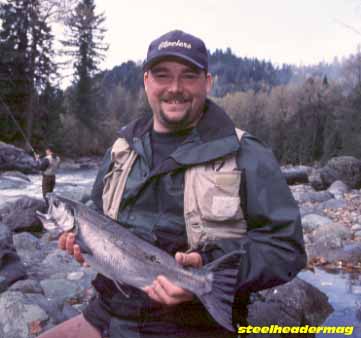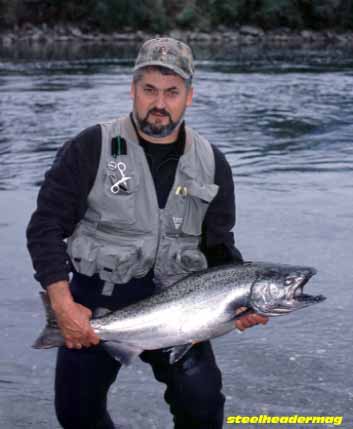|
Fall
defined
Roderick Haig-Brown
From Fisherman’s Fall
Fall comes quite
gradually on the Pacific Coast of Canada, so gradually that one
scarcely knows when or whether it has arrived. Sometimes a storm
blows up from the south early in August, with a cold, wet rain
that brings a subtle change. Yet it is certain the sun and the
hot days will come again and perhaps hold on through most of
September. If they do, there will be early frosts to turn the
leaves and insist that fall is here. More often a storm around
Labor Day brings the change. Again, the dry hot days may return
after it, perhaps bringing woods’ closure and forest fires;
but the change will be clear; fogs will force in from the ocean
and the morning dew will be everywhere. With or without frost,
the leaves will turn and begin to fall.
Fall is also in the
return of the salmon to their rivers – not, of course, in the
early king salmon runs that come to a few rivers in May or the
early running races of sockeye, but in the typical pink salmon
runs that come in towards the end of July. With their coming the
great fall movement to the coastal rivers begins. The big kings
follow quickly, in August and September. A few cutthroat trout
may have begun their movement even a little before the
humpbacks. The cohos come in with the rains of September and
October, the chum salmon are close behind them, and often with
them, in October and November. Well before the last of the
salmon is dead, it is December and unquestionably winter.
Fall fishing is a
revival after the quieter times of summer. Cooler nights and the
melt of early snowfall in the mountains bring falling water
temperatures and rains freshen the streams. Shadows are longer,
shielding the pools. The fish are more active and there is a
touch of urgency about it all, a feeling that it cannot last
very long so one had better get out and be doing. After all,
there have been falls when the heavy rains came early and
suddenly, the streams flooded and everything was over before it
had started. Occasionally such memories trick me into going out
and searching for runs before they have come in, using up
fishing time that might have been better spent a week or two
later. But I am not at all sure this is ever a matter for real
regret, because there is always something around in the fall and
one can come upon surprises – a few migrant fish running ahead
of their time, an unexpected hatch that brings resident fish on
the feed or even some phase of movement wholly unsuspected in
other years. Few movements of wild creatures run to an exact
timetable, year in, year out, and few are without their aberrant
individuals; and few of us know our own familiar waters quite so
well as we think we do.
Fall is almost
everywhere a prime fishing time. In early fall the arctic
grayling reaches his peak of fatness and condition and the lake
trout move towards shallower water and their spawning. Brown
trout and eastern brook trout are fall spawners, the cutthroat
is chiefly a winter spawner; all three take on a special beauty
of coloration as maturity approaches, echoing the reds and golds
of the falling leaves. One may look for the bright and silvery
immature fish among these and even prefer him, but his beauty is
less vivid and he is not set apart as a sign of the season.
There is much pleasure
in fall fishing, especially on streams where salmon run. But one
does not have to fish to make the most of it. Of all times of
the year on the Pacific watershed, fall is the most exciting.
Spring is the most beautiful time, summer perhaps the most
delightful, winter the most testing, at least physically; but
fall is the time of movement. Anyone who passes along the
streams may see it and feel it. Even when I am hunting ruffed
grouse or Wilson’s snipe, I find myself pushing out to the
stream edges, following them where I can, looking down into the
fall-dark water to search for the salmon’s movements among the
drifting leaves. Traveling fish roll up in the heavy water,
spawners splash and work and struggle on the shallows, exhausted
fish shelter in the eddies. Bear trails are worn and muddy along
the banks, prints of coon and mink show up on sand bars and
other soft places. Mallards, mergansers and goldeneyes start up
from the quieter reaches where they have been feeding on salmon
already dead. Being a fisherman, one looks for trout among the
salmon or checks the brightness of the cohos to see if any are
still worth taking, one studies the pools and runs and, when
they are unfamiliar, promises oneself to come back some other
time to test them. But none of this is necessary. It is enough
to be on hand at this solemn, untidy time when the woods are wet
and quiet and the salmon are completing their cycle.
To some people, the
thought that the salmon, all Pacific salmon of all species, die
very soon after spawning is a depressing one. They see in it
only decay and waste, a sort of pathetic frustration of life.
This is a natural view, but it does not question deeply enough;
the end of the salmon is not death and corruption, but only
fall, the autumn of their cycle. They come to the spawning
gravels in all their brilliant colors – reds, browns, greens,
gray and black and golden. Like the autumn leaves above them,
they have their time of fierce glory. Then the frosts and the
rains and the winds come. The leaves become torn and sodden and
dulled and in their time they fall, covering the ground,
drifting with the stream currents, piling against the rocks and
shallows. But within the trees life is still strong and self-
renewing.
 As the winds stir and
drift the dying leaves, so the waters drift and stir the dying
salmon against the gray-brown gravels of the stream beds. But
under those gravels life is strong and secret and protected in
the buried eggs, the real life of the race. Fungus grows on the
emptied bodies, as it grows among the fallen leaves; they
collect in the eddies and strand on the gravel bars and the
bacteria of change work in them to make a new fertility. In
spring life will burst from the gravel as it bursts again from
the trees, into the massive yield of the new cycle. Death is
seldom more fleeting or more fertile
than this. As the winds stir and
drift the dying leaves, so the waters drift and stir the dying
salmon against the gray-brown gravels of the stream beds. But
under those gravels life is strong and secret and protected in
the buried eggs, the real life of the race. Fungus grows on the
emptied bodies, as it grows among the fallen leaves; they
collect in the eddies and strand on the gravel bars and the
bacteria of change work in them to make a new fertility. In
spring life will burst from the gravel as it bursts again from
the trees, into the massive yield of the new cycle. Death is
seldom more fleeting or more fertile
than this.
The salmon runs are not
the whole story of fall on the Pacific Coast streams, but no one
can fish there and not be aware of them and no fisherman can
fail to be curious about them and concerned for them. A great
commercial fishery depends on them. Tens of thousands of anglers
go out each year to catch them in the salt water and every
angler who fishes a migratory stream sees them and finds his
sport, directly or indirectly, through them, for the power of
the runs persists through the year and affects all other fish.
But the salmon runs are
more than this. They are a last true sample of the immense
natural abundances of the North American continent. They have
been damaged and reduced in many places, it is true, and in some
places, especially the Columbia River, the damage is great and
permanent. But they remain a massive abundance, complex and
wonderful, throughout most of their range, and throughout much
of it their potential of natural abundance is as great as ever,
while new understanding of their ways and needs suggests that
increase over the natural abundance may well be possible through
man-made assistance.
I feel this as a
special challenge to mankind in general and to North Americans
in particular. Is there one wild thing on the face of the earth
that we can use and live within reasonable harmony, preserving
and even enhancing its natural magnificence? The record
to date suggests there is not, that our own demanding and
untidy living habits must always destroy, if not the creature
itself, then certainly the living space it depends upon. Yet for
the salmon it would seem there is some hope. It is a valuable
creature, fundamentally and irreplaceably valuable as a source
of food in a hungry world. Much of its living space is the sea,
an area of the globe that we have not so far found it possible
or necessary to change or damage very greatly. The rest is in
the streams, which our own interests demand that we keep as
clean and pure as possible. Unhappily, we often consider it
convenient to obstruct, divert or otherwise abuse them, but
there is at least a possibility that we may develop beyond these
primitive practices in time to save a good deal for the salmon.
This, I admit, is a
rather special viewpoint in an age of relentless change and
destruction. It reflects intangible values and instinctive, even
primitive, sympathies that are not much in favor today. But when
I come to write of a fisherman’s autumn I am bound to think
first of the salmon and then, remembering the sense of wonder
they have stirred in me through nearly forty seasons, I am bound
to plead their case and tell what little I know of them. I hope
they will long be here, in the waters of California, Oregon,
Washington, British Columbia and Alaska, to stir fresh wonder in
the hearts and minds of later human generations.
Roderick Haig Brown was a self taught
magistrate in Campbell River BC. He wrote 27 books about fishing
and outdoors. Haig Brown died in 1976.
Back to The Great
Outdoors
|